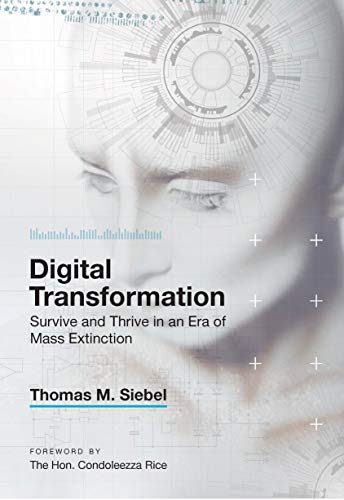If you are looking for information about the real background to digital transformation, and how to make it work, I can’t do better than recommend a book from software pioneer Tom Siebel (Thomas M. Siebel: Digital Transformation. Survive and Thrive in an Era of Mass Extinction, New York: Rosetta, 2019).
Tom has a deep understanding of converging technological disruptions, and gives clear advice on how companies can survive in what he describes as “an era of mass extinction”. He recommends stopping the ‘do it yourself’ approach to AI that so many companies have tried. Instead, he says that successful organizations must build their applications on a totally new technology stack, based on a model-driven architecture.
Four main accelerators
The book starts with a brief analysis of the four main accelerators of the information age:
(1) Elastic cloud: Instead of setting up, running and maintaining their own infrastructure, companies can now rely on cheaper and better cloud infrastructure offered by multiple providers. They offer a pay-per-use model which allows organizations to scale up fast, and save money when shutting down.
(2) Big Data: There is a lot of value hidden in the data sources inside a company - and even greater potential by blending those with external data. The amounts of data are just so massive that extracting value exceeds traditional data processing capabilities. However, if you can make use of your data, it can give you real benefits in highly competitive markets.
(3) The AI renaissance: There is hype around AI, but it has real potential. We now have all the necessary computing power to deploy AI, plus new algorithms and massive parallelized infrastructure. This provides the technology to automate decision-making on a large scale.
(4) The Internet of Things: There are now millions of sensors connecting intelligent production lines, machinery, self-driving vehicles and so on. This adds to the volume of data, and also provides a new quality of connectivity.
Recognizing the pattern
New business models are likely to be created at the intersection of these four disrupters. Digital transformation is no longer about improving operations. Instead, it will disrupt business models from their core, and change how we think. For example, car manufacturers will no longer sell cars but mobility from A to B.
The process that we are seeing now has happened before with new technologies: companies are starting to experiment. Tom Siebel, a software veteran, recognized parallels with the early days of ERP systems, and particularly the history of SAP. The founders of SAP saw that, as consultants, they programmed almost exactly the same processes for every client, and they could capitalize on this to create a software solution. Their major competitors, however, were not other software companies, but the CIOs who claimed to build everything themselves.
The same thing is happening with AI. Companies that invest in AI often create innovation labs, hire hundreds of developers and set up a new infrastructure for their digital business models. They proudly follow a do-it-yourself model. Their architecture is either based on dozens of open source applications or on cloud services provided by the big cloud players.
Solving problems - and creating others as:
Complexity. It takes a lot of effort to build and maintain an architecture based on different frameworks and following different standards of quality.
Applications based on very specialized coding are more likely to fail if even a small component is no longer supported.
Future-proof. It is not very likely that current technologies will still be state-of-the-art in a few years’ time. Re-writing the architecture will be expensive.
Data integration. Starting with a common data lake or even a consistent data model will fail in the era of ever-changing standards and types of input data.
You could argue that these problems are all solved by cloud providers. For example, AWS offers tested and integrated services as a foundation for building apps. This, however, causes another problem: you are trusting a single cloud platform with the core of your future business. A much better strategy is to be “polyglot cloud-enabled”, to combine the best services for your business across multiple clouds. This avoids vendor lock-in and will allow you to benefit from innovation by all cloud providers.
It is also, however, important to develop model-driven architecture. To do this, companies need to set up a new technology stack. This AI platform will be able to manage complexity, provide governance, security and stability, enable future-proof technology enhancements, and work across different clouds. The book provides several case studies to support these ideas, plus some examples where companies tried (and failed) to build their own digital infrastructure. Tom Siebel argues that this will always be too expensive, too risky and too late in such a fast-moving world.
Two pieces of advice stood out for me in Tom Siebel's book: re-educate your leadership team and pick your partners carefully. Click To TweetA ‘down to earth’ read
I like the ‘down to earth’ approach of this book. It boils the discussion of digital transformation down to practical issues to be addressed in every business. Two pieces of advice really stood out for me. The first is to re-educate your leadership team. Tom Siebel suggests a list of must-read books for executives to help them understand the nature of the world we are living in. My suggestion would be to start with his book. The second piece of advice is to pick your partners carefully.
So, not to put too fine a point on it, how can I help you survive and thrive?

